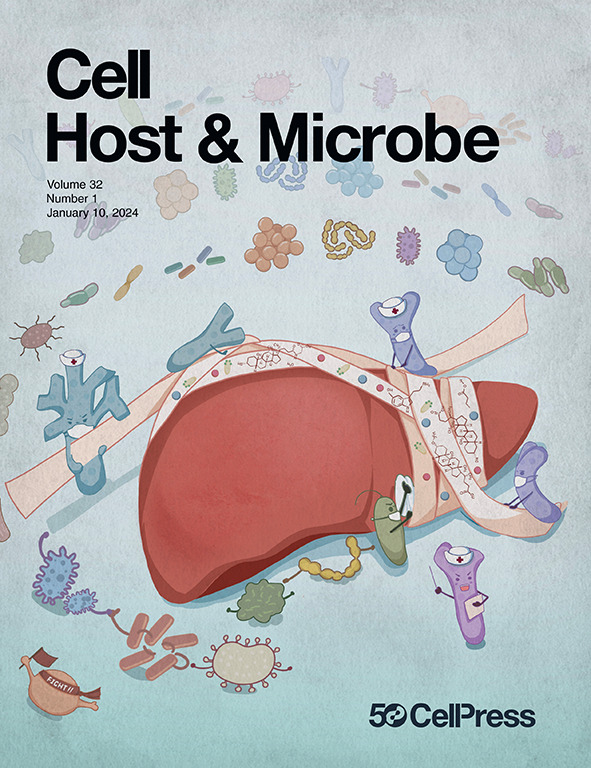A Vibrio-specific T6SS effector reshapes microbial competition by disrupting Vibrio bioenergetics
IF 18.7
1区 医学
Q1 MICROBIOLOGY
引用次数: 0
Abstract
Type VI secretion systems (T6SSs) are widely distributed among Vibrio species, yet their roles in the coexistence of toxigenic and non-toxigenic strains remain unclear. Here, we report an orphan T6SS effector-immunity module, T6SS effector specific to Vibrios (TseVs)-cognate immunity protein (TsiVs), primarily harbored by non-toxigenic Vibrio cholerae. TseVs exhibits robust vibriocidal activity, specifically targeting susceptible Vibrios lacking the TsiVs. TseVs forms dual-membrane, ion-selective pores that collapse Na+/K+ homeostasis, resulting in membrane depolarization and ATP depletion. Remarkably, non-Vibrio bacteria evade TseVs through proton motive force (PMF)-dependent resilience, uncovering an immunity-independent defense strategy. Furthermore, tseVs-positive non-toxigenic V. cholerae strains are globally distributed and have dominated in recent decades, highlighting TseVs’s ecological significance in Vibrio population dynamics. By linking TseVs bioenergetic targeting mechanisms to Vibrio population shifts, we demonstrate how T6SS effectors shape microbial genetic diversity. Our findings suggest that TseVs represents a promising model for precision antimicrobial strategies, minimizing collateral damage to commensal microbiota.

一种弧菌特异性T6SS效应物通过扰乱弧菌生物能量学来重塑微生物竞争
VI型分泌系统(t6ss)广泛分布于弧菌中,但其在产毒株和非产毒株共存中的作用尚不清楚。在这里,我们报告了一种孤儿T6SS效应免疫模块,T6SS效应特异性针对弧菌(TseVs)同源免疫蛋白(TsiVs),主要由非产毒性霍乱弧菌携带。tsev表现出强大的杀弧菌活性,特别是针对缺乏tsiv的易感弧菌。tsev形成双膜、离子选择孔,破坏Na+/K+稳态,导致膜去极化和ATP耗竭。值得注意的是,非弧菌细菌通过依赖质子动力(PMF)的弹性来逃避tsev,揭示了一种不依赖免疫的防御策略。此外,tsev阳性的非产毒霍乱弧菌菌株在全球分布,并在近几十年来占主导地位,突出了tsev在弧菌种群动态中的生态意义。通过将tsev的生物能量靶向机制与弧菌种群变化联系起来,我们展示了T6SS效应物如何塑造微生物遗传多样性。我们的研究结果表明,tsev代表了一种有前途的精确抗菌策略模型,可以最大限度地减少对共生微生物群的附带损害。
本文章由计算机程序翻译,如有差异,请以英文原文为准。
求助全文
约1分钟内获得全文
求助全文
来源期刊

Cell host & microbe
生物-微生物学
CiteScore
45.10
自引率
1.70%
发文量
201
审稿时长
4-8 weeks
期刊介绍:
Cell Host & Microbe is a scientific journal that was launched in March 2007. The journal aims to provide a platform for scientists to exchange ideas and concepts related to the study of microbes and their interaction with host organisms at a molecular, cellular, and immune level. It publishes novel findings on a wide range of microorganisms including bacteria, fungi, parasites, and viruses. The journal focuses on the interface between the microbe and its host, whether the host is a vertebrate, invertebrate, or plant, and whether the microbe is pathogenic, non-pathogenic, or commensal. The integrated study of microbes and their interactions with each other, their host, and the cellular environment they inhabit is a unifying theme of the journal. The published work in Cell Host & Microbe is expected to be of exceptional significance within its field and also of interest to researchers in other areas. In addition to primary research articles, the journal features expert analysis, commentary, and reviews on current topics of interest in the field.
 求助内容:
求助内容: 应助结果提醒方式:
应助结果提醒方式:


